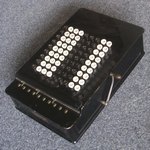
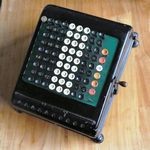
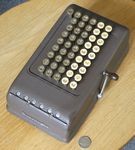
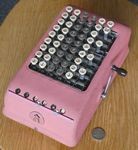
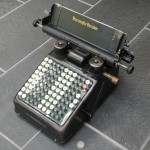
The Burroughs Adding Machine Company
The evolution of the Burroughs Calculator
My Shoebox Burroughs Calculator
Video
My Class 5 Calculator
My Baby Burroughs Calculator
Comparison Video
My "Princess Anne" Baby Burroughs Calculator
The Burroughs Portable
My Burroughs Portable 81002
Video
Manuals, Books, Magazines, and Tables
Advertisements, brochures, and sales leaflets
Newspaper and Magazine Articles
Paraphernalia
Patents
Links
William Seward Burroughs invented an adding listing machine in 1884. It took a few
years to develop it into a usable machine, and in 1888 the American Arithmometer
Company was formed in St. Louis to manufacture and market it. William Burroughs died
in 1898. Six years later the company moved to Detroit, and was renamed the Burroughs
Adding Machine Company in honour of its founder. His grandson, William S. Burroughs
is the well known beat generation author.
The early Burroughs adding machines, called the "Burroughs' Registering Accountant" or the Class 1, were quite large and heavy, and were often placed on their own metal table stand. They were listing machines, i.e. they had the ability to print the results, though the printing mechanism may have been an optional extra. There were glass panels on all sides of the casing so that the mechanism was visible to the user, because apparently many people were sceptical and mistrustful of the salesmen for these newfangled machines. Various models of these Class 1 machines were made until the 1930s. Class 2 machines were very similar, but had two registers. Burroughs were early adopters of electricity, supplying electrically driven adding machines as early as 1906.
In the trailer for the film The Greatest Showman you can see a scene in
which Hugh Jackman is playing P.T. Barnum before he was famous. He is
in a large office sitting behind a desk, and working on a class 1 Burroughs
adding machine. The office has about 30 desks, half of which have a Burroughs
machine, all without printing mechanisms. This is highly anachronistic since
the scene is supposedly set in the early 1830s, seventy years before these
machines were used in such quantity.
The Pike Adding Machine Company had developed a much smaller adding listing machine. This relatively compact machine could sit on a desk, and the printed paper came out of the top, like a typewriter or cash register, making it easier to see the result. The Burroughs Adding Machine Company took over the Pike Adding Machine Company in 1909, and these small adders then became Class 3 Burroughs machines. They were marketed as the Visible Burroughs. Burroughs would often aggressively buy out smaller rival companies before they grew large enough to compete, and then further develop or discontinue the acquired machine designs. For example they bought Universal in 1908 but did not use their designs. The Class 4 Burroughs machines are similar to the Class 3 but with a "multiplying keyboard".
The Burroughs listing adding machines had easily outcompeted Felt & Tarrant's Comptograph, but Felt & Tarrant was too large a company to take over due to the success of the Comptometer. In 1911 Burroughs decided to go head to head with them by releasing their own non-listing key-driven calculator that was very similar to the Comptometer. The Burroughs Calculator was called the Class 5 series of machines. For more information, see the section below about the evolution of the Burroughs Calculator.
In 1912 Burroughs advertised that they had 86 different models, with 492 combinations. This shows that they were masters at customising their machines to the exact special applications that their customers needed.
The Class 6 was similar to the Class 1 and 2 machines, but included direct subtraction. The Class 7 was a billing machine, originally made by Moon-Hopkins, but then by Burroughs after the company was bought in 1921.
The Class 8 introduced in 1925 was called the Burroughs Portable, and was a smaller adding listing machine with a large number of variations due to its clever modular design. It was similar in style to the portable machines made by Burroughs competitors such as Wales, Barrett, Standard, and others, and despite the competition was an extremely popular machine. The Class 9 was similar but with direct subtraction functionality, and class 10 was a special variant for use as cash registers or by bank tellers.
Burroughs remained very successful with their many adding listing machines, and also cash registers, typewriters, bookkeeping machines, as well as various other office machines, and developed a large range of machines for various more specific business operations such as bank processes. They also successfully made the transition into the electronic age, by buying electronics companies to produce early tube computers, tape storage machines, and later electronic calculators. Between 1966 and 1968 Burroughs computer equipment could be seen on television in the Batman series starring Adam West, as the Batcomputer, and also in other series like the Time Tunnel and Lost In Space. In 1986 the company merged with the Sperry corporation to become Unisys.
1911-1914: Shoebox model
In 1911 Burroughs decided to compete directly with Felt & Tarrant,
creating a a non-listing key-driven calculator. Burroughs deliberately
styled the case of their new calculator to look very similar to the
Comptometer. In Britain they even called it the Burrometer. It had one
column/digit more, so that their salesmen could claim that the Burroughs
machine was better. Through litigation Burroughs were forced to change
the design in 1915, making Burroughs calculators with the shoebox casing
somewhat rare. See below for pictures of
my Shoebox Burroughs Calculator
1915-1936? Leggy model
In 1915 the Burroughs Calculator was redesigned. The new version had a different
key mechanism that did away with the long lever that the Comptometer has, and this
allowed the machine to be shorter and the keys to be the same height. It had a black
case, with rounded corners and little legs, and with a green keyboard plate. The rear
legs could have extensions attached in order to tilt the keyboard towards the user.
This was quite a popular machine, because it was cheaper than the Comptometer, and
one of the cheapest machines that Burroughs made. That made up for the lack of error
correction mechanism, which made it somewhat unsafe to use. See below for pictures
of my Burroughs Calculator.
1928-1960?? Baby Burroughs
The 6-digit "Baby" Burroughs Calculator was released in 1928. It no longer
had metal legs but had a flat base that rested on rubber feet. These changes made it
even cheaper. The case was originally painted black with a green keyboard plate, but
later other colours were produced too. See below for pictures of my Baby
Burroughs Calculators.
1928-1936 Electric model
An electrically driven version was produced at the same time, and this was the first version
that made errors from incomplete keystrokes impossible.
1934-1936 Duplex model
The Duplex model is electrically driven and has an extra register at the top of the
keyboard for grand totals. The design of the Baby Burroughs was not yet carried over
to this model, as it still has the legs of the 1915 calculator. Note that it finally
has a row of carry suppression buttons at the front to simplify subtraction.
1937-19?? Standard Manual model
The full-sized manual model finally gets a redesigned case, though its mechanism
seems unchanged. It does not have carry suppression buttons. This model appears
in adverts from 1937, but it may have been introduced a year or two earlier.
1937-19?? Electric model
The electric model finally gets a redesigned case, matching the manual version.
This model appears in adverts from 1937, but it may have been introduced a
year or two earlier.
1937-1946 Duplex model
The duplex model also gets a redesigned case, matching the style of the manual version.
1947-19?? Duplex model
The case was restyled again. The standard manual and electric models
were also changed, but I have not found any advertisements featuring them.
It seems that the Baby Burroughs continued to be produced with at most
a change in colour.
This is the first Burroughs Calculator (as opposed to adding listing machine). It was first made in 1911 and deliberately styled to resemble the Comptometer. The patent infringement court case filed by Felt & Tarrant forced them to change this deceptive practice, so from 1915 the Burroughs Calculator had a very different design. Note that Burroughs appealed the case, and in 1917 was found not to have infringed any patents, but the case had mostly served its purpose by then.
Here are some notable comparisons with the Comptometer:
According to the instruction handbook, on the earliest versions of the shoebox Burroughs Calculator the small co-digits on the keys were printed in red, and the clearing handle was attached with a screw, but on mine the co-digits are black, and the clearing handle can be pulled free and simply clicks back into place.
My Burroughs Calculator has serial number 206979. I do not have a key for unlocking the register cover, but the part of the cover that the lock latches onto is missing so the cover can easily be removed without a key. There are several scratches on the top plate of the case, but otherwise the case is in good condition including the logo on the front. Mechanically it still works perfectly.
Here is a video where I demonstrate my shoebox Burroughs Calculator.
This is the version of the calculator that replaced the shoebox model in 1915. It became known as the Class 5. It still has 9 full columns of keys, 10 digits in the register, though versions with more columns were made too. This particular machine has fractions (eighths) in the rightmost column. It has a cast iron casing, with small legs on the corners. The rear legs have extensions so that the keyboard is tilted up towards the operator, but those are optional - they can be unscrewed, and the rubber feet screwed in their place.
The keyboard mechanism has changed so that it no longer requires long levers. The case is therefore not as long as before, and only barely extends past the top most row of keys. The mechanism also blocks you from pressing two or more keys in the same column.
The zeroing mechanism is different to that of the shoebox model. It was changed to be quieter and require less effort. Whereas pulling the lever used to increase all digits to 9, and then let them carry over when the lever was released, pulling the lever now merely uncouples the digit wheels so that the springs used in the carry mechanism can pull them down to zero.
I think it probably used to have a Burroughs logo decal on the front, but there is no trace of it now. It has serial number 5-672171, which means it was probably made in the year 1920.
The standard Burroughs Calculator has 9 or more full columns of keys. Starting in 1928 they also made a version of about half the size, so 5 keyboard columns, with a 6-digit register. This was of course even cheaper than the full-sized version, and this helped it become quite popular. It is sometimes known as the "Baby Burroughs".
The casing has been simplified - it no longer has a cast iron base with legs, but now has a simple flat base with rubber feet screwed on. The zeroing mechanism has some extra safety compared to the older models, in that the keyboard remains locked if you do not complete the movement of the lever, and this prevents only partially clearing the register.
The colour of this calculator and the fact that its logo is not a decal suggest that it was probably made in the 1940s. From 1947 Burroughs started using a round red logo with the letter B, but this machine still has Burroughs in full so it probably dates from before then. It has serial number A720100.
Here is a video where I compare three types of Burroughs Calculator.
This is a very special 1953 edition of a Baby Burroughs Calculator. Instead of a black or brown case, its case is painted pink, and in place of the round red Burroughs logo on the front it has a cursive letter A. Also, the keyboard plates are transparent, making the mechanism somewhat visible. It comes in a carrying case with a tartan lining.
The machine is set up for British currency calculations. The first two columns are normal decimal for the number of pounds. The middle two columns count shillings. There are 20 shillings in a pound, so the keys in the third column are all marked 1, the number wheel only displays 0 and 1, and it carries over every second step. The next column is for pennies, so the number wheel can display 0 to 11. The keys for 10 and 11 pennies are shifted to the right to the top of the last column of keys. That last column is for farthings, so has keys marked ¼, ½, and ¾. The number wheel also has markings for eighths, but these are skipped over.
This Burroughs Calculator was made in Scotland. The Strathleven Industrial Estate opened in December 1946, and Burroughs was first major company to move in. Queen Elizabeth II visited the plant on April 16 1953. This was about a year into her reign, and six weeks before her coronation. During that visit, two special Burroughs Calculators were presented to the Queen and Prince Philip: A blue calculator with a C on the front and a pink one with an A. They were gifts for their children Princess Anne and Prince Charles, who were 2 and 4 years old at the time. The calculators had leather carrying cases lined with tartan, and special leather bound instruction booklets based around nursery rhyme themes.
I do not know how many of these special editions were made, but there were at least two of each - one pair presented to the royal couple, and a duplicate pair that Burroughs used for exhibition purposes. I do not know if the one I have is one of those. It still has the leather carrying case lined with tartan, but there is no instruction book.
My "Princess Anne" Burroughs Calculator does not have a serial number. A few screws are missing from the casing, but other than that it looks in perfect condition, as if it were made yesterday. Unfortunately the register has become misaligned, and I have not yet been able to get it to work properly.
The Charles Babbage Institute, part of the University of Minnesota Libraries, owns the archives of the Burroughs Corporation. In this archive there are black and white photographs of the Queen's visit to the Strathleven factory, and of the presentation of the two Baby Burroughs machines.
The Burroughs Portable was introduced in late 1925. It was an answer to the increasing competition from calculator companies like Wales, Barrett, Standard, and others, who were making smaller adding listing machines that were considered portable in comparison to earlier machines. The Burroughs Portable was designed in such a way that its mechanism consists of separate modules that can be relatively easily replaced. This also allowed for many variations. For example the base machine could easily be fitted with one of several paper feeding mechanisms.
The Burroughs Portable was classified internally by Burroughs as the class 8 machine. The Class 9 was similar but had a mechanism that could do direct subtraction, and the class 10 was a special variant for use as cash registers or by bank tellers.
The model variants were given a 5-digit number that specified the style of machine:
| A | BB | C | D | |
|---|---|---|---|---|
| A | All model numbers start with the class number, usually 8. | |||
| BB | These two digits denote the number of columns of the keyboard, generally 06, 08 or 10. | |||
| C | This digit is 0 for manually driven machines, or 5 for electrically driven ones. | |||
| D | This digit denotes further variations, such as the type of paper feeder or special keyboards. It is 1 for a narrow printer roll mechanism, 2 for a typewriter-style paper feeder with a movable carriage, and 8 for a keyboard with 1/8th fractions. |
The class 8 is a very basic adding machine. It has an internal register which is not directly visible to the user. If you enter a number on the keyboard (at most one digit per column) and pull the large handle that is on the right hand side of the machine, then the number is printed, and added to the internal register. The keyboard is automatically cleared, unless you first push the Repeat button. If you press the Total button and pull the handle then the current value in the register is printed, with an asterisk next to it to indicate this is the final total, and the register is cleared. If instead you press the S-Total button and pull the handle, the current value is printed with an S next to it, but the register is not cleared, so this is just an intermediate result, a subtotal. If you enter a number, press the NA (Non-Add) button, the number is printed with a # next to it, but it is not added to the register.
This Burroughs Portable has a normal keyboard with 10 columns, and a typewriter type of paper feeder, which makes it a model 81002. The paper mechanism has a large knob on either side with which you can turn the roller that feeds the paper past the print heads. There is a small lever on the right with three settings for the automatic line spacing (double-spaced, single spaced, disabled). Behind that is spring-loaded lever that allows you to shift the carriage in either direction until it clicks into place at another tab position. The tab positions can be defined by placing small metal clips at various places on a metal rack at the back of the paper feeder. The button on the left releases the paper, allowing you to position it more precisely. There is a paper roll spindle on the back that can be used instead of loose leaves.
The serial number is located just below the bottom row of the keyboard, and is 8-1218360. This means this machine was made in about 1928.
The paper feeding mechanism is attached to the body of the machine with just 4 screws. When those screws are removed it is easily lifted off. The mechanism is connects through two arms, of which the larger one drives the paper feeding, and the smaller one drives the ink ribbon. The small switch nearby disables both.
The casing comes off after removing the handle and the two screws at the front edge. The internal register is a row of gears located in the rear section, with the carry mechanism at the back. It looks like the rear section can be removed relatively easily, and the same is true for the keyboard. When the handle is pulled, bars that lie underneath each key column move upwards, and they are connected to toothed racks that drive the associated register wheels. If a key is depressed, its stem forms an obstruction causing that bar to halt its movement prematurely, and so apply the appropriate digit to the register.
Here is a video where I demonstrate my Burroughs Portable.
There is now a separate web page for Burroughs Manuals, Books, and Tables.
Cheer Up and 52 Reasons Why
Burroughs Adding Machine Company; Detroit, Michigan, U.S.A.
1907 (Second edition)
59 page book
80mm × 114mm × 6mm
This tiny promotional book contains 52 reasons to acquire a Burroughs adding machine. The back cover has a reply postcard attached. The edges of the pages are not cut, so they are very uneven.
A Better Day's Work at a Less Cost of Time, Work, and Worry to the Man at the Desk
Burroughs Adding Machine Company; Detroit, Michigan, U.S.A.
1910 (Fourth edition)
192 page book
130mm × 190mm × 13mm
This promotional book contains a short history of adding devices ending with the development of the Burroughs adding machine, 25 chapters each showing an example of how a Burroughs machine can handle some administrative business task, and descriptions of many variants of Burroughs adding listing machines that were available.
Shown here is the Fourth edition from 1910. It does not yet mention the Burroughs Calculator, but no doubt the sixth edition from 1912 does. It has a list of the dates and amounts of all editions of this book up to that point:
| First Edition | 10,000 | October 1908 |
| Second Edition | 25,000 | December 1908 |
| Third Edition | 50,000 | March 1909 |
| Fourth Edition | 50,000 | May 1910 |
Helping Ford Handle His Millions A Romance in Dollars and Cents (PDF, 19.1 MB or archive.org)
Burroughs
1915 (First edition)
36 page book
107mm × 152mm × 8mm
This is a small hard-cover book with a dust cover. It explains what Burroughs
machines have improved the working of banks. There is a fold-out copy of a
bank statement that is generated by a Burroughs machine. A back page has a
reply postcard attached. The edges of the pages are not all cut, so they are
very uneven.
There is no copyright year in the book, but the text contains financial data
from May 1915, so it is likely from that year.
Burroughs Brochure (PDF, 31.9 MB or archive.org)
1929?
116 page ring bound book
216mm × 130mm (binder), 200mm × 126mm (pages excluding tabs)
This is a brochure advertising the many kinds of Burroughs machines that were available. It is a leather ring-binder with 116 thick yellow pages that have tabs to separate it into the sections Counter Uses, Misc. Uses, Multiplying, Special Lines, Other Styles, Calculator, and Accessories. Its binding system is unusual. It has fixed rings, and the paper leaves have slots to go over the rings and a straight metal wire rod is then inserted through the rings in the centrefold of each set of leaves to lock them in place. The rear cover is marked "Michigan Book-Binding Co., Detroit, 25224".
It has no copyright year. It includes the Burroughs Portable, so it dates to after 1925. As one of the illustrations of a form uses the year 1929, I assume it is from that year.
La Burroughs Portable
1929?
1 perforated page
212mm × 274mm
This is a fact-sheet in French for the Burroughs Portable listing adding machine. It was included in the French instruction manual so is presumably from around 1929. The Portable model was released in 1925 or 1926.
Fascinating Figure Puzzles (PDF, 4.98 MB or archive.org)
Compiled by Frederick W. Davis, A. A. of the Burroughs Adding Machine Company
Copyright 1933 (Printed 1952)
28 page booklet
18mm × 147mm
Form G 1005
This small promotional booklet contains lots of mathematical puzzles, with answers at the back. The last few pages contain adverts for various Burroughs machines.
The Story of Figures (PDF, 11.5 MB or archive.org)
Burroughs Adding Machine Co.
June 1952
36 page stapled booklet
Booklet 137mm × 191mm × 2mm, Envelope 203mm × 153mm
This booklet is a short history of the development of numbers, arithmetic,
and mechanical calculators, ending with William Burroughs' adding machine.
The last few pages show a range Burroughs machines and other equipment.
There is no copyright year in the book, but the code inside the rear
cover indicates this edition is from June 1952. There was an edition
from 1933 which differed only slightly in the last few pages - instead of
machine supplies and microfilm equipment it showed more about typewriters,
cash registers, and office chairs.
It came in its own envelope, with the same form number as the booket itself, G 1029.
I don't own any physical copies of Burroughs newspaper articles. I have however found a few interesting articles in online newspaper and magazine archives. I have put them on a separate Burroughs Articles page.
Order Receipt September 16, 1903
This is an order for a dozen rolls of paper for use in the Burroughs adding listing machine, from the Peoples Bank in Pratt, Kansas. The company was still called the American Arithmometer Company and based in St. Louis.
Letter October 9, 1903
This is a letter to the Peoples Bank in Pratt, Kansas, from the American Arithmometer Company, acknowledging the return of a temporary machine. The letter heading has a picture of the Burroughs adding machine.
Oct. 9,1903
Peoples Bank,
Pratt, Kans.
Dear Sir:--
We beg to acknowledge receipt of our machine No.
1021, which you used as a substitute during the time your
machine was being repaired.
We trust that your own machine is now doing satis-
factory work, but would appreciate it if you would advise us
promptly when in need of information regarding it.
Yours very truly,
D-L.
Letter June 3, 1908
This is a letter to the Peoples Bank in Kansas, from the Burroughs sales department. The letter heading is relatively plain, but still mentions that they used to be called the American Arithmometer Company.
GNP-FHH
June 3,1908
The PeoplesBank,
Pratt, Kans.
Gentlemen:-
⸿ This will acknowledge receipt of and
thank you for contract covering deferred payments of
$275.00, which with an allowance of $100.00 of the
amount already paid on machine 7N-67567 is in settle-
ment for one style No. 9 BURRØUGHS Adding and List-
ing machine.
⸿ It is agreed in accepting this sale
that we are to cancel contract covering machine 7N-67567.
There has been $125.00 paid on this contract, $100.00 of
which we have applied on the new contract and the
balance of $25.00 as rental for machine 7N-67567.
⸿ Thanking you for this order and assur-
ing you that you have only to call upon us at any time
we can be of service, we are,
Yours very truly,
Letter June 9, 1908
This is a another letter to the Peoples Bank in Kansas, from the Burroughs secretary and treasurer B.G. Chapman.
June 9, 1908
Peoples Bank,
PRATT,
KANSAS.
Gentlemen:-
⸿ We acknowledge receipt of your
remittance amounting to $62.50 covering par-
tial payment for one No.9 BURRØUGHS ADDING
AND LISTING MACHINE.
⸿ Thanking you, we are,
Yours very truly,
MGP-EMK B.G. Chapman
Burroughs Keychain
This keychain is shaped like a medallion with the Burroughs logo in the centre, and around that it is decorated with symbols of the four arithmetic operations. The reverse is plain. It is probably from the late 1950s or early 1960s.
Burroughs Lighter
This lighter has the Burroughs logo on one side and a 10-key adding listing machine on the other side. It is probably from the late 1950s or early 1960s.
Burroughs School Certificate
Burroughs set up schools to train operators, much in the same way as Felt & Tarrant had done with their Comptometer Schools. This is a certificate from such a school in Pittsburgh, dated November 2, 1950, and made out to Mary Jane Race Gault. It is a fairly small card, contained in a wallet that looks like leather but which is also made of cardboard.
The Burroughs Adding Machine Company filed a large number of patents about all aspects of their many machines. The shoebox Calculator has two patent dates printed on its case, which are the first two listed below. The other two describe changes made in the 1915 redesign.
| Patent | Filing date | Publish date | Name | Description |
|---|---|---|---|---|
| US 1,016,501 | 18 Apr 1911 | 6 Feb 1912 | Allen A. Horton | Burroughs Calculator. |
| US 1,023,168 | 5 Jul 1911 | 16 Apr 1912 | Walter J. Pasinski | Improvement to carry mechanism. |
| US 1,128,679 | 24 Feb 1914 | 16 Feb 1915 | Claiborne W. Gooch | Improved carry mechanism and clearing mechanism. |
| US 1,156,600 | 15 Sep 1914 | 12 Oct 1915 | Allen A. Horton | New keyboard mechanism |
© Copyright 2016-2020 Jaap Scherphuis, mechcalc a t jaapsch d o t net.